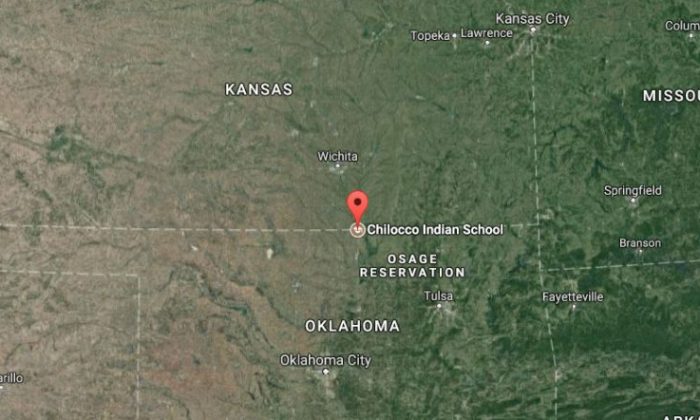News
Biological Weapons Simulation to Happen in Oklahoma, Using Insecticide Lethal to Monarch Butterflies

Biological weapons might be as far from the minds of typical Americans as they are remote in threat potential; yet, the Department of Homeland Security is planning a live simulation of a bio attack — in a small Oklahoma town on the Kansas border.
Unsurprisingly, the town’s residents are none too thrilled about the plan.
DHS announced last week it plans the biological weapons simulation for early in 2018 — and, again, during the summer — at the Chilocco Indian School, seven miles north of the town of Newkirk. FOX23 reports a legal notice appearing in local media stated “non-hazardous, non-toxic” chemicals and biological materials will be released on buildings in the area to determine how much protection structures would offer, should a real attack take place.

The Chilocco Indian School. (Screenshot, Google Maps)
“I just got sick to my stomach,” Dennis Jordan, a resident of Newkirk, told KOCO. “I think if they want to test that stuff, let them go to Los Alamos, you know? I think it’s stupid.”
Titanium dioxide — described as a “white odorless powder that is chemically insoluble in water, nonreactive, nonflammable and nonhazardous” — will be released for the particle portion of the test.
However, for the biological weapons scenario, the government plans to release an organic insecticide sold under the name, DiPel, which specifically targets lepidopteran, or worm, species considered pests to agriculture.
As FOX23 notes of the biological simulation, “the government plans to release genetic, barcoded spores of an insecticide sold under the trade name of Dipel. Dipel is not considered hazardous by the Environmental Protection Agency when handled appropriately, according to an assessment.”
Neither FOX23, nor KOCO provided any further information or links for said assessment. However, The Epoch Times linked to a draft evaluation ‘environmental assessment’ of DiPel and the other materials to be used in the test, posted on the DHS website — ostensively that noted by the other outlets and unnamed government officials — which also cites the EPA deeming the insecticide safe under certain circumstances.
“I have numerous questions regarding this proposed test,” asserted U.S. Rep. Ron Estes of Kansas, who acknowledged Thursday he is now “monitoring the situation closely.”
“While it’s important for our federal agencies to test their abilities in response to threats,” he added, “we need to be 100 percent certain this test is safe for the residents of south-central Kansas.”
Indeed, the government appears to stand by its assertion DiPel will not be toxic to the area, as residents nearby weren’t even informed by DHS or other officials the tests will be performed.
“You would think you would let your neighbors know,” Kyle Oestmenn, who lives less than a half mile from the now-deserted Chilocco Indian School, told KOCO. “Hopefully they stop by and let me know at least.”
Scant reports suggest the only information about the biological weapons test came from the aforementioned legal notice — leaving many to discover the news from friends and neighbors — if they have found out about the plans, at all. Entire cities have been left in the dark.
“This is the first time the city has been made aware of any testing to occur at Chilocco,” Arkansas City, just over seven miles from the abandoned school, posted to social media on Thursday, as cited by FOX23. “Inert means chemically inactive, which means by definition there should be no risk to the citizens. However, we are looking into the situation to gather more information for our citizens and their safety.”
Although the operation will follow strictures of the National Environmental Policy Act, there are several caveats pertaining to DiPel, which — although the substance’s general safety around humans, plants, and companion and other animals isn’t in question — must be duly noted.
First, the nature of DiPel as a lepidopteran pest control material means that, while nontoxic to most everything else, it affects worms — and, thus, caterpillars and larvae — particularly harshly.
Renowned entomologist and ecologist Lincoln Brower, who won the E. O. Wilson award in 2016 for his work, has more than six decades of expertise on monarch butterflies — including study of how certain genetic modifications to crops used in mass agriculture horrendously damage the storied pollinators.
In fact, earlier this month, Brower wrote extensively about the impact of Bt corn for Orion Magazine — modified through the introduction of certain bacterium to repel pests — on the monarch population.
Noting decades of failed introductions of alien species into the United States to combat pests safely, Brower discusses the utter folly that is Bt corn — and why the its use is cause for grave concern. After countless attempts at a biological solution to worm pest control, the world expert in monarch butterflies writes, manipulation of the soil bacterium Bacillus thuringiensis turned the delicate ecosystems necessary to sustain pollinators on its head.
“The Bt bacterium secretes a protein that, when ingested by a sensitive insect, causes the larval gut to break down and a gooey, black death ensues,” Brower writes. “Industrial and academic scientists have selected numerous Bt strains that are toxic to the larvae of different groups of insects. The Bt kurstaki strain is lethal to the caterpillars of virtually all moths and butterflies and is produced in mass cultures that are harvested and sold as Dipel. Used in home gardens as a ‘natural’ toxic powder to kill tomato hornworms and cabbage caterpillars, Dipel is also sprayed to kill gypsy moth caterpillars in the eastern deciduous forests, spruce budworms in the northern boreal forests, and tussock moth caterpillars in the western Douglas fir forests. Extensive sprayings of Dipel and its derivatives, along with repeated releases of exotic parasitic insects, have severely reduced the populations of many benign and beneficial native insects, including several of the New England silk moths renowned for their elegance and bizarre caterpillars.”
In his next paragraph, however, Brower unwittingly proffers further evidence the designation of DiPel as ‘safe’ by the EPA amounts to an arbitrary, cursory evaluation of the product — without accounting for the extraneous but brutal damage to species, like the monarch, which aren’t specifically targeted.
“Many biologists heralded the new Bt corn technology because they believed it would mitigate the need to spray insecticidal chemicals. The corporations involved in marketing the seeds (for the most part the same ones that had developed the synthetic insecticides several decades earlier) sponsored a multimillion-dollar campaign touting them as an environmental panacea. The response was stunning: by the 1998 season, twenty-five percent of the total U.S. corn crop (of eighty million acres) was planted with Bt corn.”
Bt kurstaki — again, “lethal to the caterpillars of virtually all moths and butterflies,” according to Brower — is the type to be used for the biological materials portion of DHS’ terror attack scenario, which will take place in the heart of spring monarch migration territory in January or February, and again in June or July, next year.
DHS emphasizes the use of the particulate and biological agents will have no impact on civilians, animals, plants, or anything coming into contact with it; and, while this is factual, the omission of potential effects to sensitive species in the area — an abandoned building and tract — should not be ignored.
Severely critical of myopic government policies rooted in sloppy science, Brower writes,
“A major issue that emerges from the Bt corn debate is the way in which scientific information is obtained and used in the federal regulatory process — a question with consequences far greater than the decision to register or ban Bt corn. As the handling of the monarch saga has shown, the EPA’s October 2000 decision was based on scientific information that was largely controlled by the industry and failed to measure up to even minimum standards adhered to by the international scientific community. These standards require peer review of manuscripts by independent scientists chosen by the editorial boards of scholarly scientific journals. Peer review assures that experiments are reproducible, that the data are statistically valid, that the conclusions are logically derived from the data, and that they state clearly what is and what is not resolved. This independent evaluation of scientific evidence is a sine qua non for the integrity of science. By ignoring the standard of peer-reviewed science and by relying on information supplied by the same corporations that it means to regulate, the current U.S. federal regulatory system is severely flawed.”
Delving into the Bt corn debate is far from the purview of this article — but the dearth in information given to residents and officials by the Department of Homeland Security on the upcoming tests; the choice of an abandoned building centered in the monarchs’ spring migration routes; that the government is choosing to conduct these tests in a civilian setting, rather than in one of its own facilities; and the fact the United States suffers a relatively minuscule number of terrorist attacks to prepare for in the first place, make this biological weapons testing simulation a testament to the State’s lack of foresight and hush tendencies.
Then again, this simple simulation could indeed be just a preparedness test.
Images credit: Shutterstock, Google Maps
Typos, corrections and/or news tips? Email us at Contact@TheMindUnleashed.com
